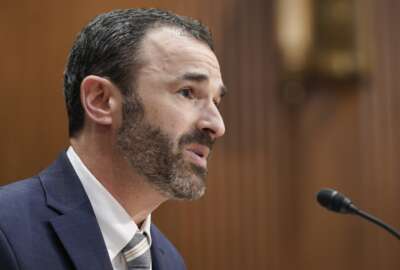DorobekINSIDER: The Gov 2.0 status report — where are we now?
What is gov 2.0, what does it mean, and is it still a relevant term? Those were the questions that were being bandied about at a dinner last week of gov 2.0...
What is gov 2.0, what does it mean, and is it still a relevant term?
Those were the questions that were being bandied about at a dinner last week of gov 2.0 luminaries in preparation for the Gov 2.0 Expo.
The second Gov 2.0 Expo is coming to Washington, DC in just a few weeks — May 25-27 at the Washington Convention Center, to be exact. Produced by tech publishing giant Tim O’Reilly, the guy who all but invented the term “web 2.0.”
One of the remarkable evolutions over the years has been the changing government IT market. And it is very easy to overlook how much progress has been made. When I started covering this stuff for Government Computer News nearly two decades ago (my colleague at Federal News Radio, Tom Temin, hired me for the job at GCN — small world), people would often ask, ‘The government uses computers?’
My oh my, how the world has changed. The remarkable thing these days is that people don’t ask that question any more. To the contrary, they often say, ‘Why isn’t the government using technology more — or more effectively.’
And while the Obama administration is widely seen as being tech innovators — and the Obama team has really taken the use of technology to new levels — but this has been a long evolution dating all the way back to the Clinton administration. Back in 1998, the thought was creating a WebGov. WebGov then evolved to FirstGov before becoming USA.gov.
Before we go too much further, it’s important to define terms. Broadly, I describe Web 2.0 (and, by extension, gov 2.0) and the suite of collaborative tools. They can be everything from Facebook and GovLoop to wikis to blogs. Gov 2.0 would be the government’s use of these tools.
WebGov/FirstGov/USA.gov and all the other government Web sites were an early foray into the Web 1.0 world.
I’m fascinated by these tools because I think they can be — for lack of a better term — real paradigm changes. We often talk about paradigm shifts, but… these tools do seem to have the ability to bring about remarkable change. Some call them “disruptive” technologies — because they do significantly alter the way people have always done business.
And there has been a whole lot going on in the gov 2.0 world in recent years:
* Intellipedia: The suite of Web 2.0 tools for the intelligence community that has been on the cutting edge for some five years now — and it is one of the case studies in MIT Prof. Andrew McAfee’s great book, Enterprise 2.0: New Collaborative Tools for Your Organization’s Toughest Challenges.
* Blogs across government… some CJD favs include Navy CIO Rob Carey and NASA CIO Linda Cureton
* Idea sharing tools such as TSA’s Idea Factory, where front line feds can offer up ideas, and they are voted on by TSA employees
The National Academy of Public Administration’s Collaboration Project has scores of case studies.
And in recent years, there are scores of luminaries who have become fascinated with government technology — perhaps led by O’Reilly, but there are others… Craig Newmark, the “Craig” of Craig’s List… Anil Dash, who all but created blogging and has now created Expert Labs… and I even was introduced just last night to Palantir Technologies, which was created 2004 by a handful of PayPal alumni and Stanford computer scientists — and with venture funding from the CIA’s InQ-Tel — and seeks to “radically change how groups analyze information.” There have even been some criticisms of the Obama-Google connections.
Many of the Silicon Valley innovators are use to… well, being innovative. And it has been remarkable to watch as they have come change government.
O’Reilly is — and has been — one of the real thought leaders. Back in 2009, he wrote a post, What Does Government 2.0 Mean To You?
The buzz at last week’s dinner was where does gov 2.0 stand today.
In a way, it is a much more complex world these days. Some of the changes require real changes — and greater risks. Some of the changes require discussions and debate — how do you deal with Internet Web cookies, for example. In the Web world, it is simple: Agencies should be able to use them. But in reality, the headline will say, ‘Government to track Web users.”
And there are complex policy discussions, like the one going on about the Government Paperwork Reduction Act. GPRA is almost universally loathed by gov 2.0 proponents, but… it is also the law.
There was a significant contingent at last week’s dinner who said that the term “gov 2.0″ actually holds the evolution of these tools back.
My sense is that the power of these tools — and people’s desire to work together to accomplish a mission — wins out in the end. They will succeed or fail based on whether they actually help agencies accomplish their missions.
For me, that remains the question: Does this help agencies do their job better?
All of that being said, this is a more complex time for gov 2.0, but we’ve already seen remarkable changes. One of the biggest change: People feel empowered. A handful of people can launch something like the Better Buy Project, which seeks to change the government procurement process. It is much more complex then merely launching a blog or using Twitter. In many ways, it is a more fundamental evolution of how government conducts its business.
There have been enormous accomplishments. It was just a few years ago that it was totally evolutionary when Andrew P. Wilson was working on redesigning the PandemicFlu.gov Web site — and merely asked for help with the question: How can we make this site better? The concept of asking for help — the notion that one could ask for help was an enormous change. it is easy to underestimate these changes, but they aren’t small, nor are they insignificant. Today, it has become a regular tool for agencies.
These changes are going to take time — and they probably should. Everybody is learning — and there is a lot to learn.
I’d be interested in your thoughts.
Copyright © 2025 Federal News Network. All rights reserved. This website is not intended for users located within the European Economic Area.





